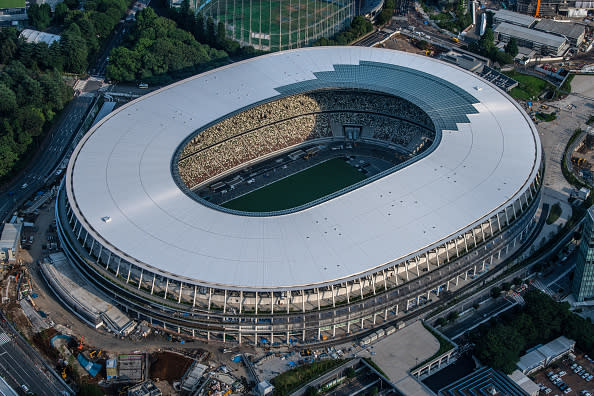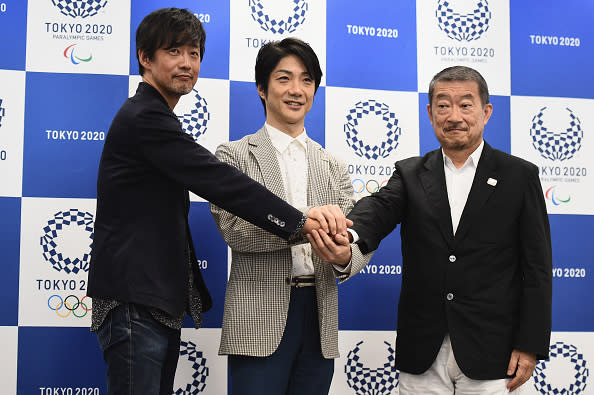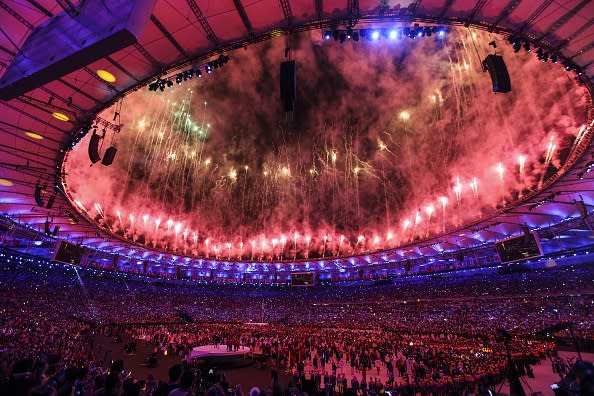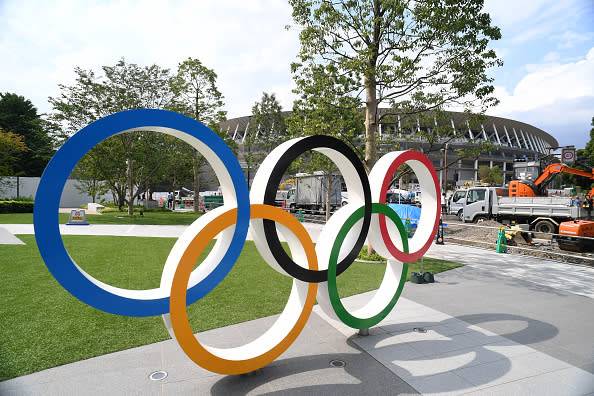Everything to Know About the 2020 Summer Olympics Opening Ceremony
With the 2020 Olympics in Tokyo now postponed until 2021 due to coronavirus, we still have about a year to go until the Summer Games return.
But before the first Summer Olympics without Michael Phelps since 1996 truly get underway next year, the 2020 Tokyo Olympics, as they will still be called, will kick off with a highly-anticipated Opening Ceremony. The Opening Ceremony has been an integral part of every Olympics since the first modern games were held in Athens in 1896 and presents an opportunity for the host country to promote its national identity to the world. The show is typically watched by hundreds of millions of television viewers globally in addition to the tens of thousands of spectators who flock to the Olympic Stadium for the proceedings.
As is tradition, the 2020 Olympics Opening Ceremony in Tokyo will be comprised of a number of key events, including the artistic program, the parade of athletes, the lighting of the Olympic flame and the symbolic release of the doves of peace.
Here’s a complete guide to the 2020 Olympics Opening Ceremony.
When is the 2020 Opening Ceremony?
The new date and time of the 2020 Opening Ceremony is still up in the air. But whenever it does take place, for those watching in the U.S., it’s important to note that Tokyo is 13 hours ahead of America’s East Coast (and 16 hours ahead of the West Coast). This story will be updated with the latest primetime schedule once available.
For the 2008 Summer Olympics in Beijing, a city with a similar time difference, NBC delayed its U.S. telecast by 12 hours to coincide with evening primetime viewing. It’s likely that the network will handle the Tokyo Summer Olympics similarly.
Where will the Opening Ceremony be held?

The 2020 Opening Ceremony will be held at Japan’s New National Stadium in the Shinjuku ward of Tokyo. The $1.5-billion, three-tiered complex designed by prominent Japanese architect Kengo Kuma is expected to seat 68,000 during the 2020 Summer Games. Capacity will be reduced to 58,000 for the 2020 Paralympics to create more room for handicap accessible seating.
The open-air, oval-shaped stadium features a wooden lattice design that evokes traditional styles seen in Japanese shrines and pagodas. Its wood and steel composite roof — which was partially sourced from Japanese-grown larch and cedar trees — opens at the center to allow hot air to escape.
The stadium is intended to blend in with the surrounding parkland and “restore the link that Tokyo lost with nature.”
Who’s planning the opening ceremony?

The three key creative directors for the Opening and Closing Ceremonies of the 2020 Olympics and 2020 Paralympics are Mansai Nomura, Takashi Yamazaki and Hiroshi Sasaki.
Nomura is a renowned Japanese actor, director and producer who is known for his work in kyogen, a form of traditional Japanese comic theater, and film. He will serve as chief executive creative director for the ceremonies, which means he will oversee production of all four events and ensure each of them stays true to an overall theme.
“Simply put, my focus is on inclusion. I don’t want to just show diversity, but to create a harmony within it,” Nomura told the Tokyo Weekender. “This concept hails from my experiences through kyogen and I consider it my mission to share it.”
Nomura has also said that he wants to incorporate Japan’s witty spirit into the ceremonies. “I want the ceremonies to be full of wit,” he told the Japan Times. “That’s something I feel strongly about. From tradition to the cutting edge, Japan has many methods and ideas that are full of wit. We want to make full use of those things in the ceremonies.”
Yamazaki, an award-winning movie director, has been appointed executive creative director for the two Olympic ceremonies while Sasaki, the creative director of the Olympic flag handover segment for the Rio 2016 Closing Ceremony, will fill the role of executive creative director for the Paralympic events.
The Tokyo Organizing Committee has also named five creative directors for the four ceremonies: movie producer and writer Genki Kawamura, creative producer Yoshie Kris, singer-songwriter Sheena Ringo, creative technologist Kaoru Sugano and choreographer MIKIKO.
What can we expect from the Opening Ceremony?

The Tokyo Organizing Committee has laid out a “Basic Policy” for the overall concept of the 2020 Olympics and Paralympics that lists peace, coexistence, reconstruction, future, Japan and Tokyo, athletes, involvement and excitement as the core themes to highlight throughout the Opening and Closing Ceremonies.
As the Olympic Charter mandates, the 2020 Opening Ceremony will combine formal ceremonial proceedings with an artistic program that showcases the history and culture of Japan.
The ceremonial aspects of the 2020 Opening Ceremony will include the entry of Japanese head of state Shinzō Abe, a performance of Japan’s national anthem, the parade of the athletes, the symbolic release of doves, the opening of the Games by Abe, the raising of the Olympic flag and performance of the Olympic anthem, the taking of the Olympic oath by an athlete, the taking of the Olympic oath by an official, the taking of the Olympic oath by a coach, and the Olympic flame and torch relay.
Details of the artistic program are usually kept secret until the day of the performance, but as was true for the Rio 2016 Opening Ceremony, Tokyo’s will likely feature thousands of performers outfitted in intricate costumes, elaborate set pieces, spectacular music and dance numbers, and appearances by renowned Japanese celebrities — one of the most exciting moments of the 2016 Opening Ceremony came when famed Brazilian supermodel Gisele Bündchen strutted down the catwalk to “The Girl From Ipanema.”
Who will attend the ceremony?
More than 11,000 athletes from 206 nations are expected to attend the 2020 Opening Ceremony in addition to the tens of thousands of spectators that will flock to the event.
As far as Team USA goes, while only a few U.S. athletes have already qualified for the 2020 Olympics, it’s likely that previous gold medalists like gymnast Simone Biles, swimmer Katie Ledecky and tennis star Serena Williams are all but guaranteed to compete in the Games — and could participate in the Opening Ceremony’s parade of nations. Qualifying competitions and Olympic Trials, which vary by sport, should take place leading up to the Games to determine the full Team USA roster.
In addition to athletes, many countries will also send senior officials to the 2020 Opening Ceremony as part of their delegations. For the 2018 Winter Games in PyeongChang, South Korea, Vice President Mike Pence and his wife, Karen Pence, led the U.S. Delegation.
What’s the history of the Olympics Opening Ceremony?

The Opening Ceremony has been an integral part of every Olympics since the first modern games were held in Athens in 1896. The ceremony represents the official start of an Olympic Games and affords the host country an opportunity to showcase their national identity on a global stage.
“The protocol and splendor of the Olympic ceremonies, which go hand-in-hand with the celebration of the Games as everyone knows them today, make this event unique and unforgettable,” the Olympic Charter reads.
However, the Charter also notes that the Opening Ceremony of today’s Games is worlds away from what took place in Athens over 120 years ago and that some elements of Olympic Opening Ceremony protocol have only been gradually established over time.
For example, while Pierre de Coubertin, the founder of the International Olympic Committee, originally envisioned the modern Olympics as a celebration of both athletic and artistic achievement, as athletics became the focal point of the Games, the artistic program portion of the Opening Ceremony continued to increase in scale.
With each successive Games, the Opening Ceremony grows into a bigger and grander event that now attracts tens of millions of viewers worldwide.

